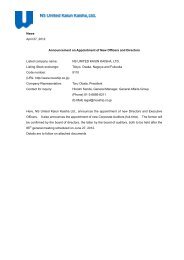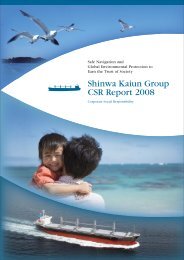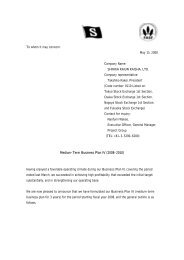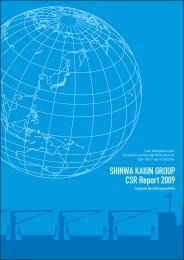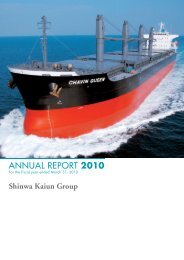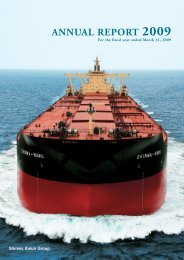SHINWA KAIUN GROUP CSR Report 2010
SHINWA KAIUN GROUP CSR Report 2010
SHINWA KAIUN GROUP CSR Report 2010
Create successful ePaper yourself
Turn your PDF publications into a flip-book with our unique Google optimized e-Paper software.
Verification of Fiscal <strong>2010</strong> Implementation Plan<br />
Environmental<br />
Management Programs<br />
and<br />
Environmental <strong>Report</strong><br />
Five-Year Long-Term Objectives<br />
(Fiscal Year <strong>2010</strong> Formulation)<br />
Environmental<br />
Policies<br />
Promotion of<br />
Safe Operation<br />
PLAN DO CHECK / ACT <br />
Environmental<br />
Objectives<br />
Target for <strong>2010</strong><br />
Preservation of the<br />
Marine Environment<br />
Zero accidental oil spills from ships<br />
Complete exchange of ballast water<br />
in the ocean<br />
Working from the voluntary action plan of the Japanese Ship-owners' Association, we<br />
and to sustain the reduction rate of fiscal year 2013 through fiscal year 2014.<br />
Content of Activities<br />
Compliance with procedures for receiving/ transferring fuel<br />
oil and lubricating oil<br />
Compliance with regulations for preventing oil pollution<br />
Recommendation to install oil-absorbing filter on deck<br />
Instruction in prevention of oil-spill accidents<br />
Set forth in sailing instructions<br />
Compliance with procedure for changing ballast water<br />
Verification of Results<br />
Target of zero accidental oil spills met by observing<br />
all the regulations and making them widely known<br />
by means of sailing instructions.<br />
Operate in compliance with procedure for changing<br />
ballast water.<br />
13% reduction in fuel oil consumption<br />
per unit load over fiscal year 1991<br />
Preparing effective operational plans<br />
Increasing loading cargo quantity<br />
Appropriate implementation of economic operations<br />
Instruction in reducing fuel-oil consumption in port<br />
Promote economic operations using BRIDGE<br />
(maritime meteorology and tidal current forecast information)<br />
14.71% reduction in fuel oil consumption<br />
per unit load over fiscal year 1991<br />
Natural Resource Saving and<br />
Reduction of Waste<br />
Conservation of<br />
Natural Resources<br />
Reduction in consumption of paper<br />
1% reduction in annual power consumption<br />
in the office over the previous year<br />
Promote use of fuel additives<br />
Promote IT leading to electronic data conversion, implement<br />
filing inspections, encourage use of electronic libraries<br />
Promote printing on both sides of paper, reuse of paper<br />
when photocopying<br />
Promoting paperless operations by introducing<br />
onboard vessel-management software<br />
Instructions and notices on in-house electronic bulletin<br />
board for turning off unused lights, computers, and equipment<br />
Saving electricity by eliminating unnecessary lighting<br />
Target was not met due to slight year-on-year rise<br />
(0.8% increase) in paper consumption<br />
Electric power consumption was reduced 3% over the<br />
previous fiscal year, so the target was met.<br />
Reduction of<br />
Waste Generation<br />
Improve landing shipboard waste<br />
(1% increase over the previous year)<br />
Complete segregation of wastes generated<br />
in the office (100%)<br />
Completely segregated collection and retention<br />
Management of quantity of shipboard waste and landing<br />
Complete segregation of recyclables, combustibles and<br />
non-combustibles<br />
On-shore disposal of on-board waste was largely reduced as follows:<br />
Fiscal year 2009: 13.97 m 3 and 158.5 kg<br />
Fiscal year <strong>2010</strong>: 10.44 m 3 and 137.23 kg<br />
Created a special corner for reused products and<br />
worked to reuse as much as possible instead of using<br />
new products.<br />
Conservation of<br />
Air Quality<br />
Reduction of Harmful<br />
Air Pollutants<br />
13% reduction in NOx emissions per unit<br />
load over fiscal year 1991<br />
13% reduction in CO2 emissions per unit<br />
load over fiscal year 1991<br />
Supply low-sulphur fuel<br />
Reduction of dioxin<br />
Adoption of improved machinery on newly built ships<br />
Select and analyze fuel with 4.5% or lower sulphur content to purchase<br />
Select and analyze fuel with 1.5% or lower sulphur content to purchase<br />
when entering an SOx Emission Control Area (SECA)<br />
Adoption of incinerators of IMO-approved type on newly<br />
built ships<br />
A reduction of 14.68% relative to fiscal year 1991<br />
Use 100% fuel with 4.5% sulphur content<br />
(1.5% in SECA areas)<br />
Adopted on newly built ships<br />
(Imabari 88-type and Imabari 76-type)<br />
Implemented GREEN FLAG INCENTIVE<br />
PROGRAM (100%) in a vessel placed in service<br />
at Long Beach Harbor in the United States<br />
Sail at 12 knots or less within 20 miles of applicable ports<br />
No vessels in service<br />
Environmental<br />
Education<br />
Promoting an<br />
Environmental Mind<br />
Education of shore employees<br />
Education of crew<br />
Practice in-house seminars<br />
Train internal environmental auditors<br />
Practice pre-boarding seminar<br />
Practice training at overseas companies<br />
Practice shipboard education of crew<br />
Education implemented during training for newly hired<br />
employees and training for career employees<br />
One person recently obtained qualification as an<br />
internal auditor for land-based divisions<br />
Implemented during pre-boarding training and ship visits<br />
12Shinwa Kaiun Group <strong>CSR</strong> <strong>Report</strong> <strong>2010</strong>



![[Consolidated] Balance Sheet (B/S)(PDF/35KB)](https://img.yumpu.com/49745625/1/184x260/consolidated-balance-sheet-b-spdf-35kb.jpg?quality=85)
